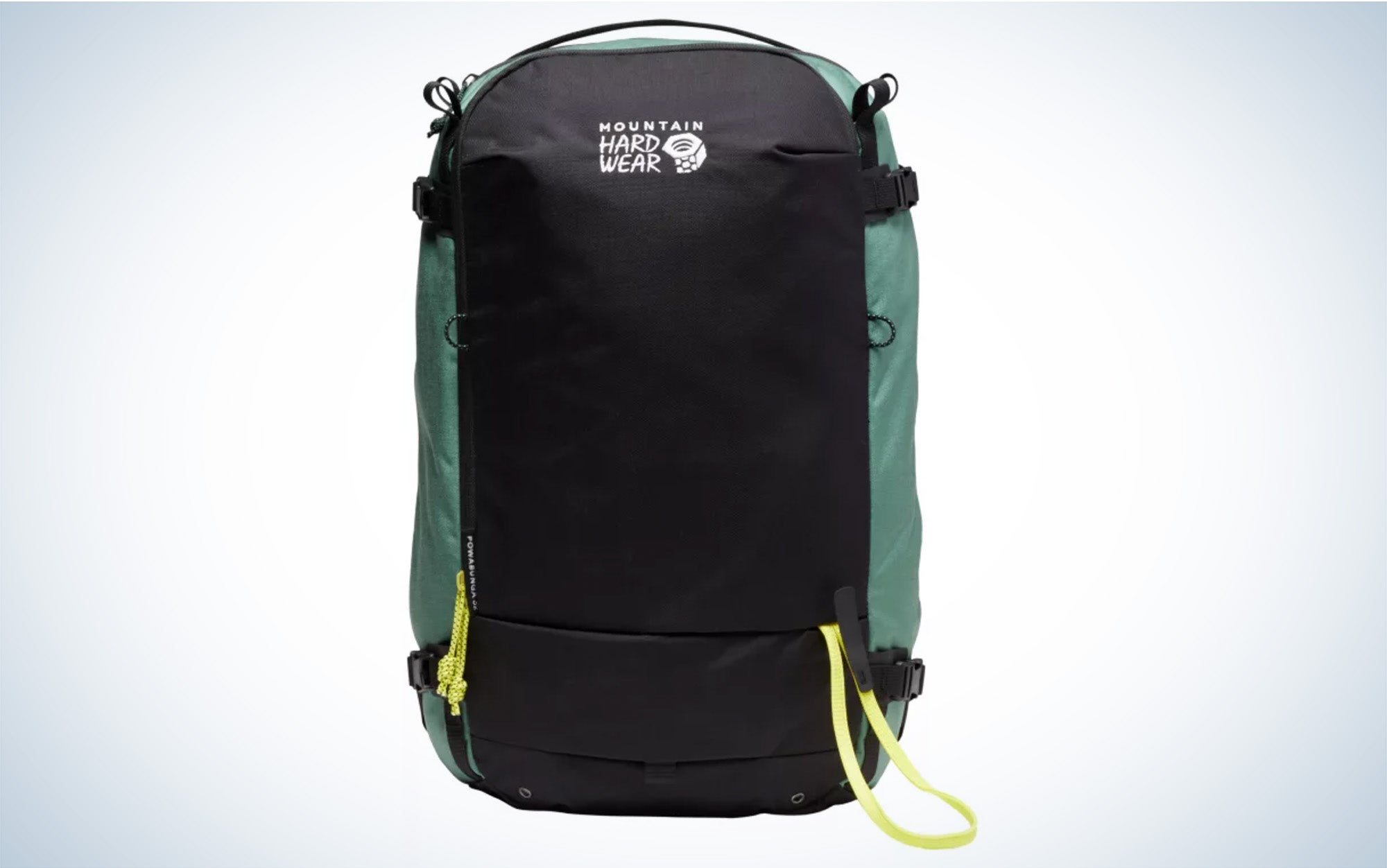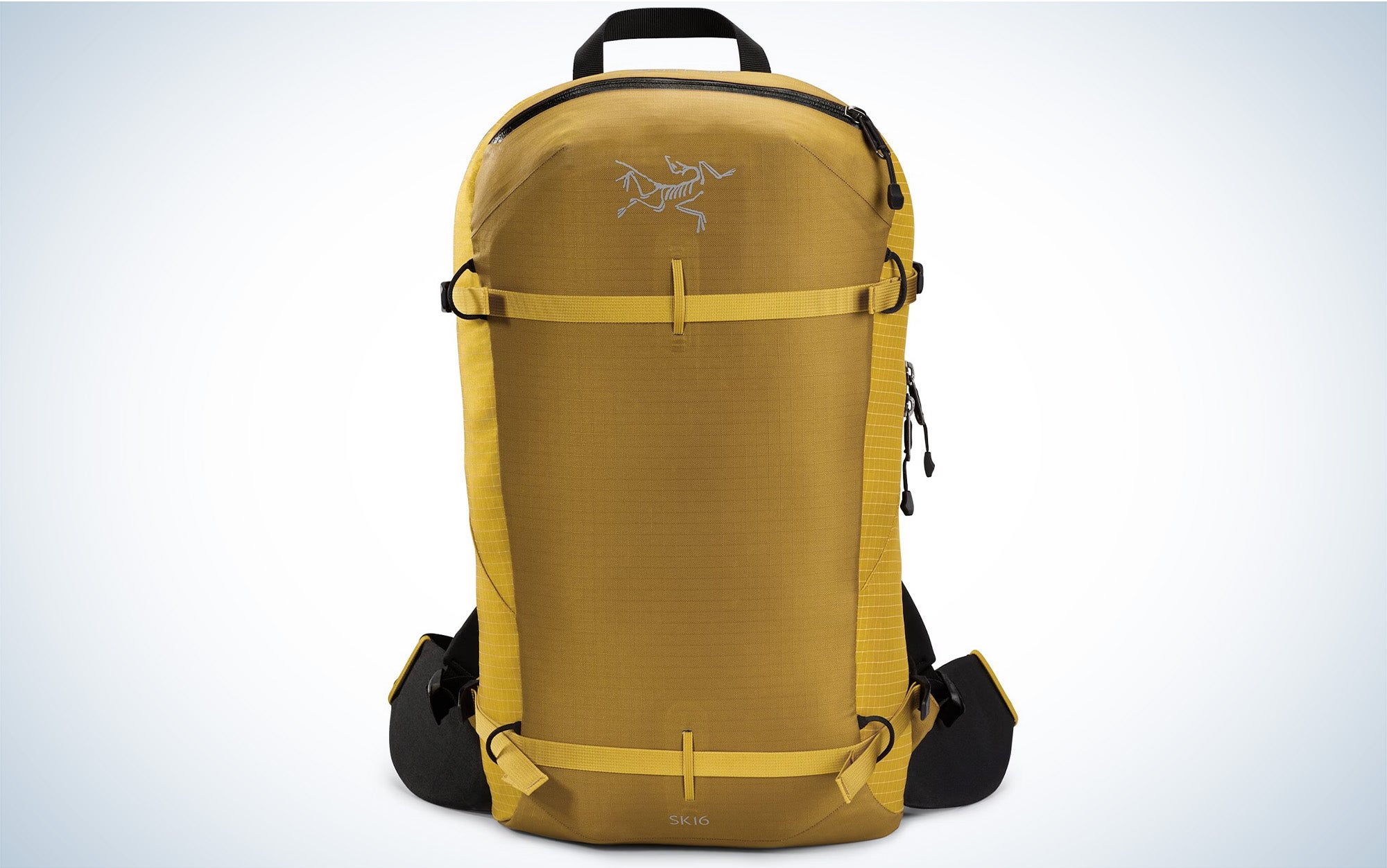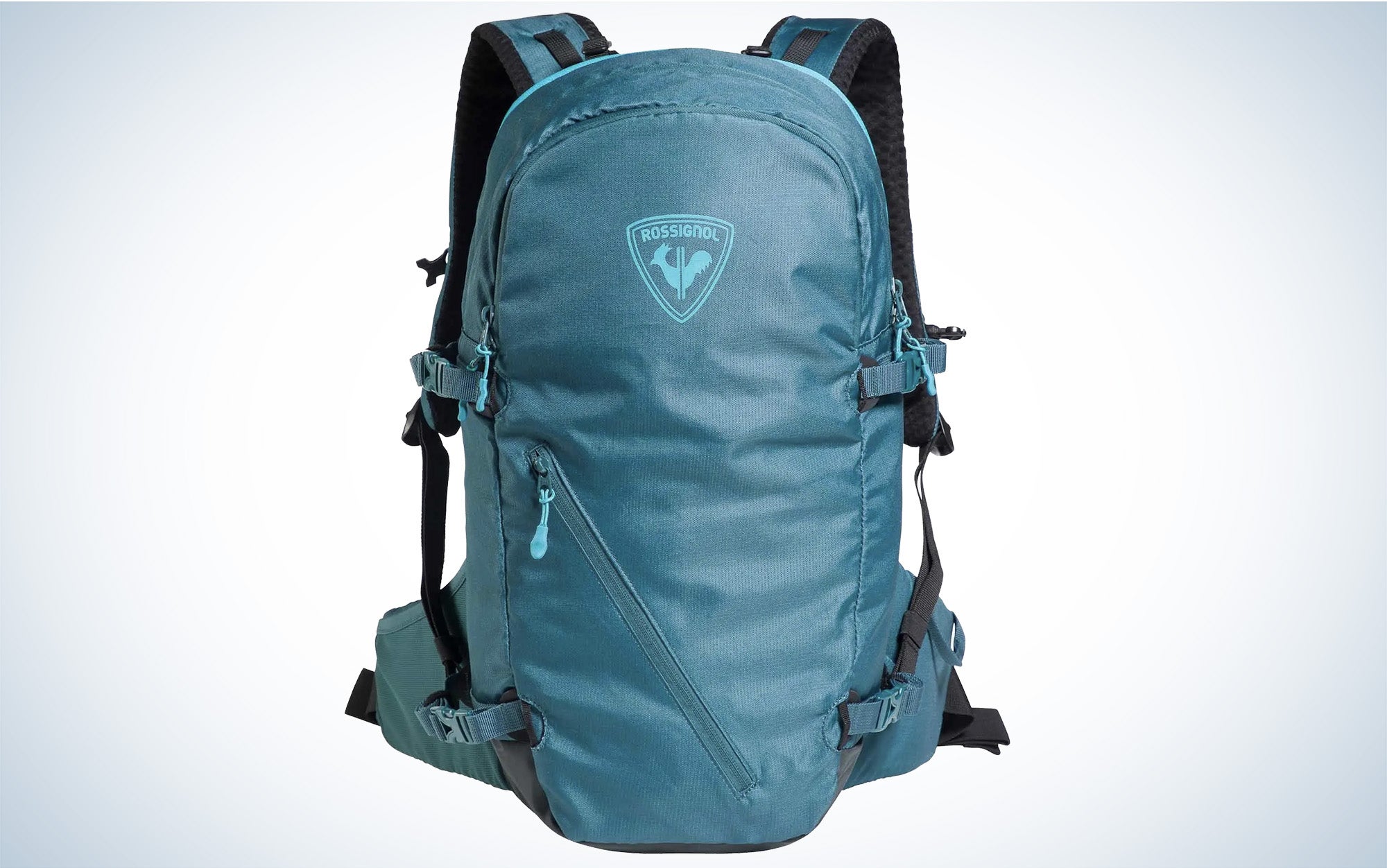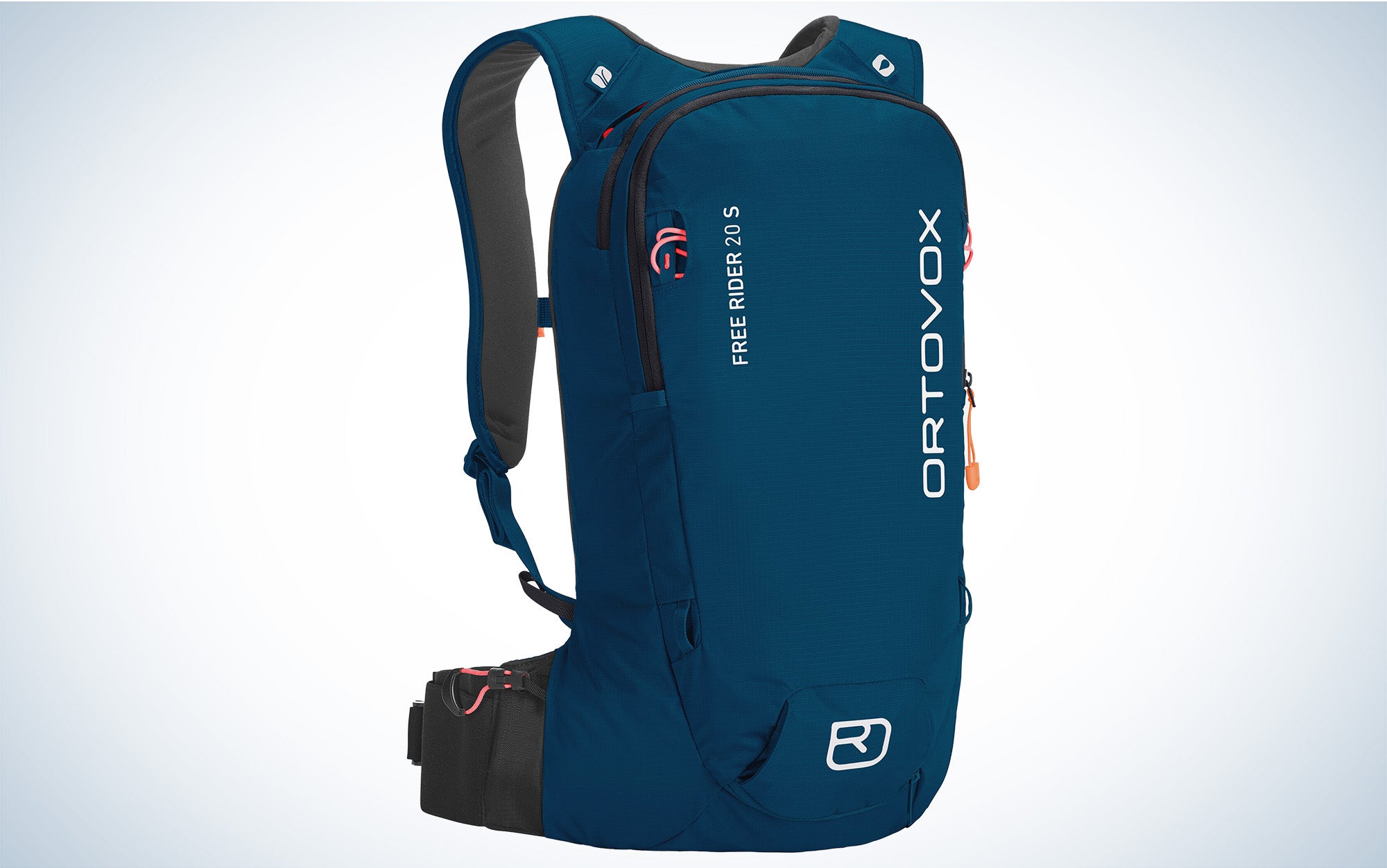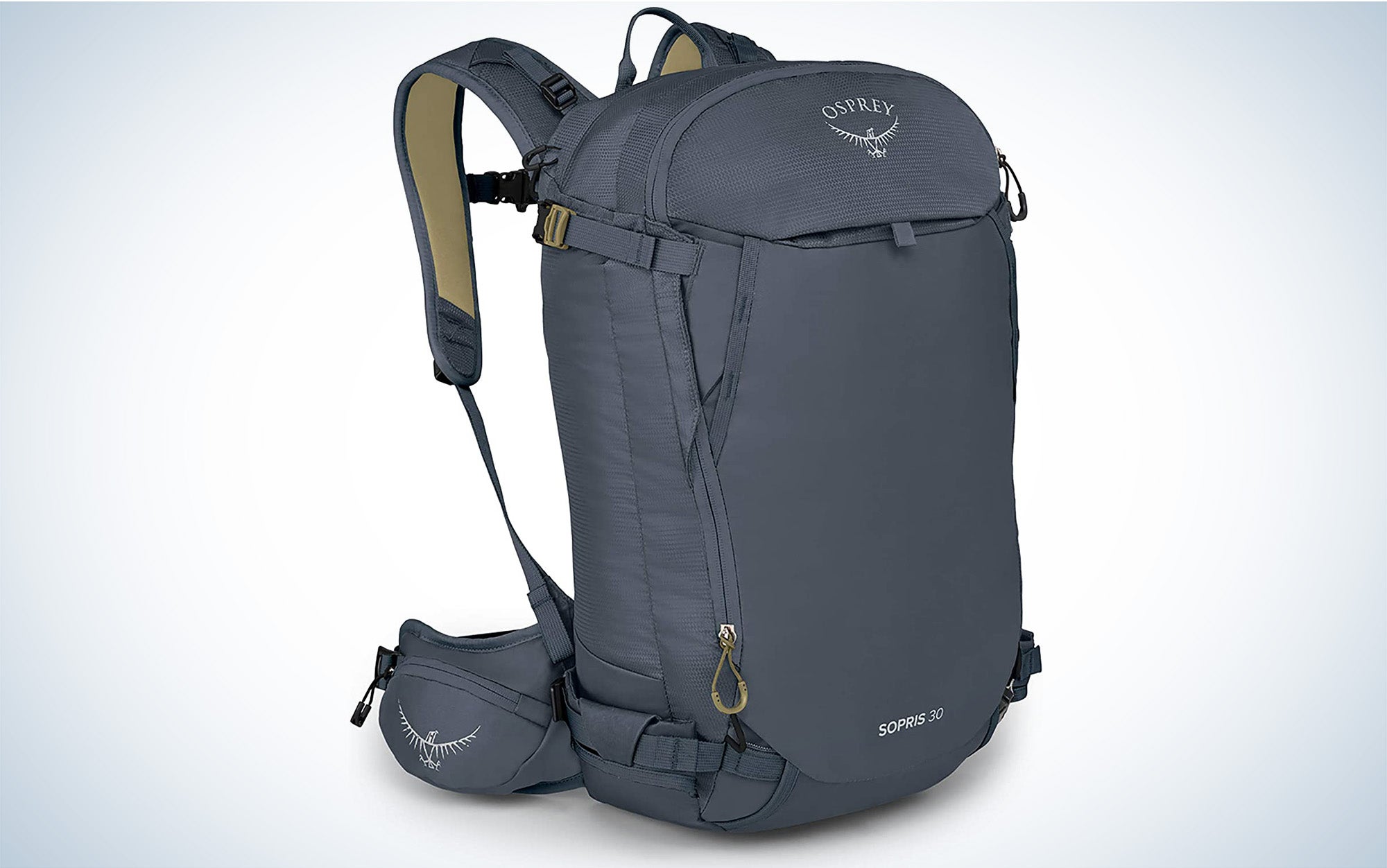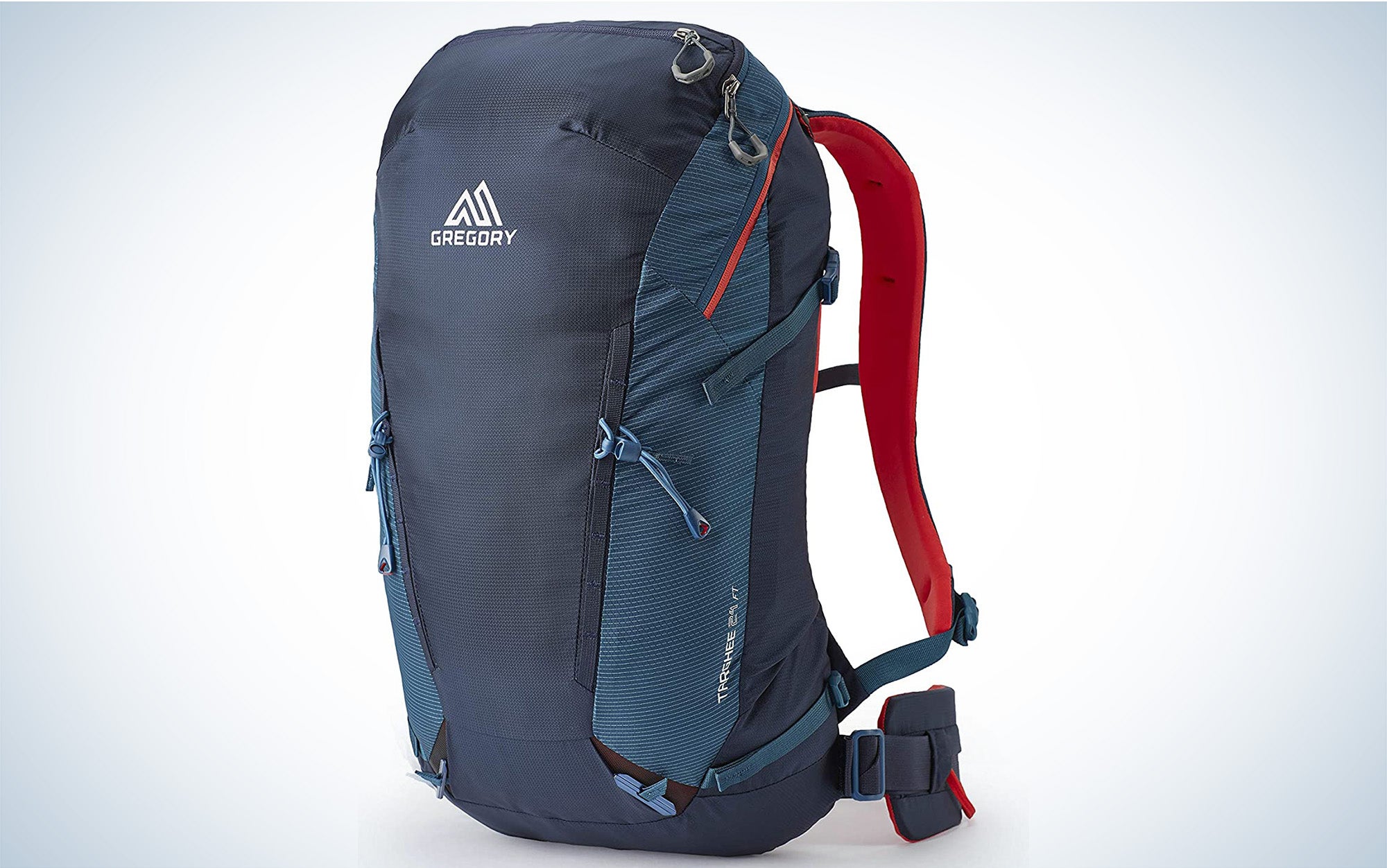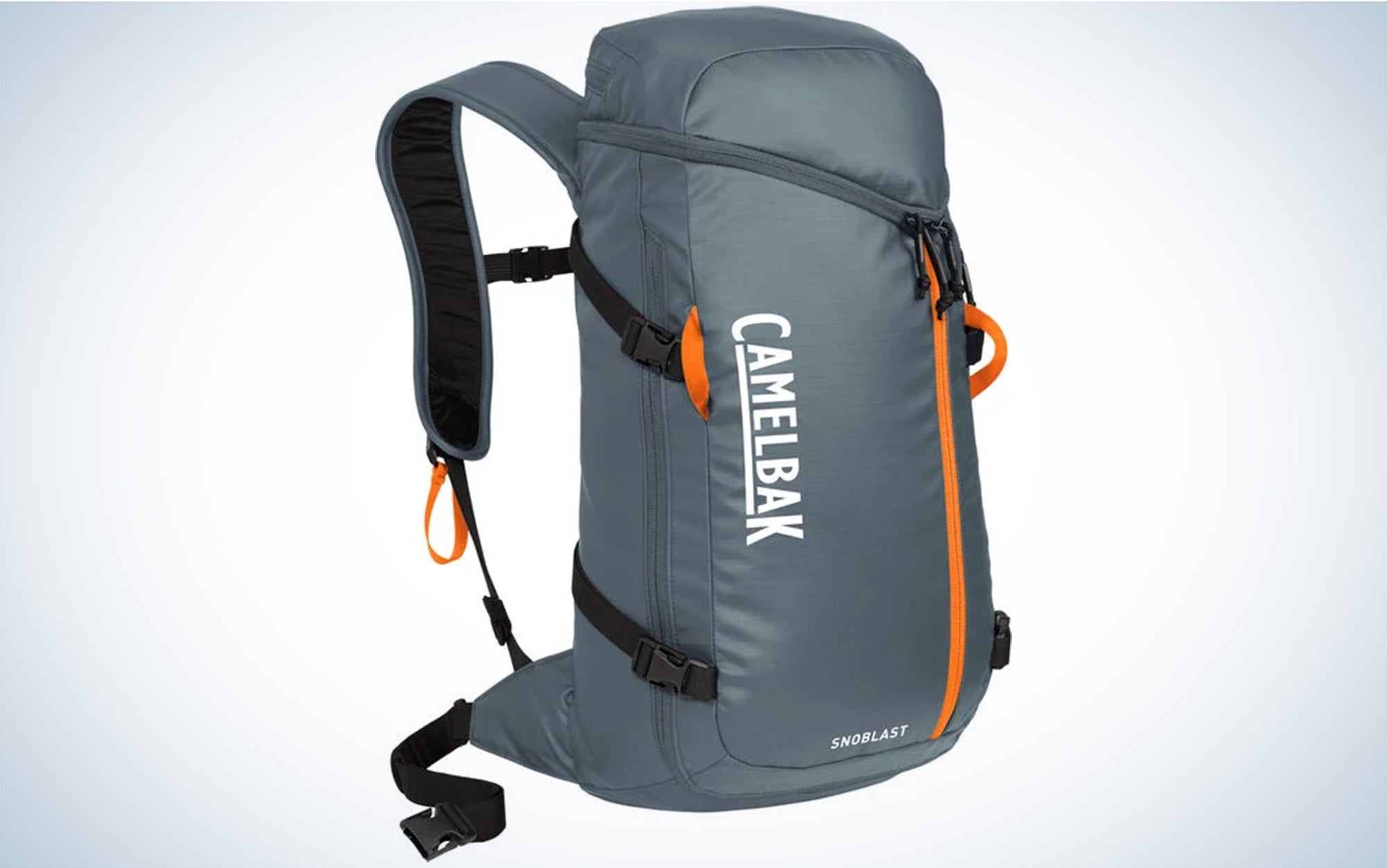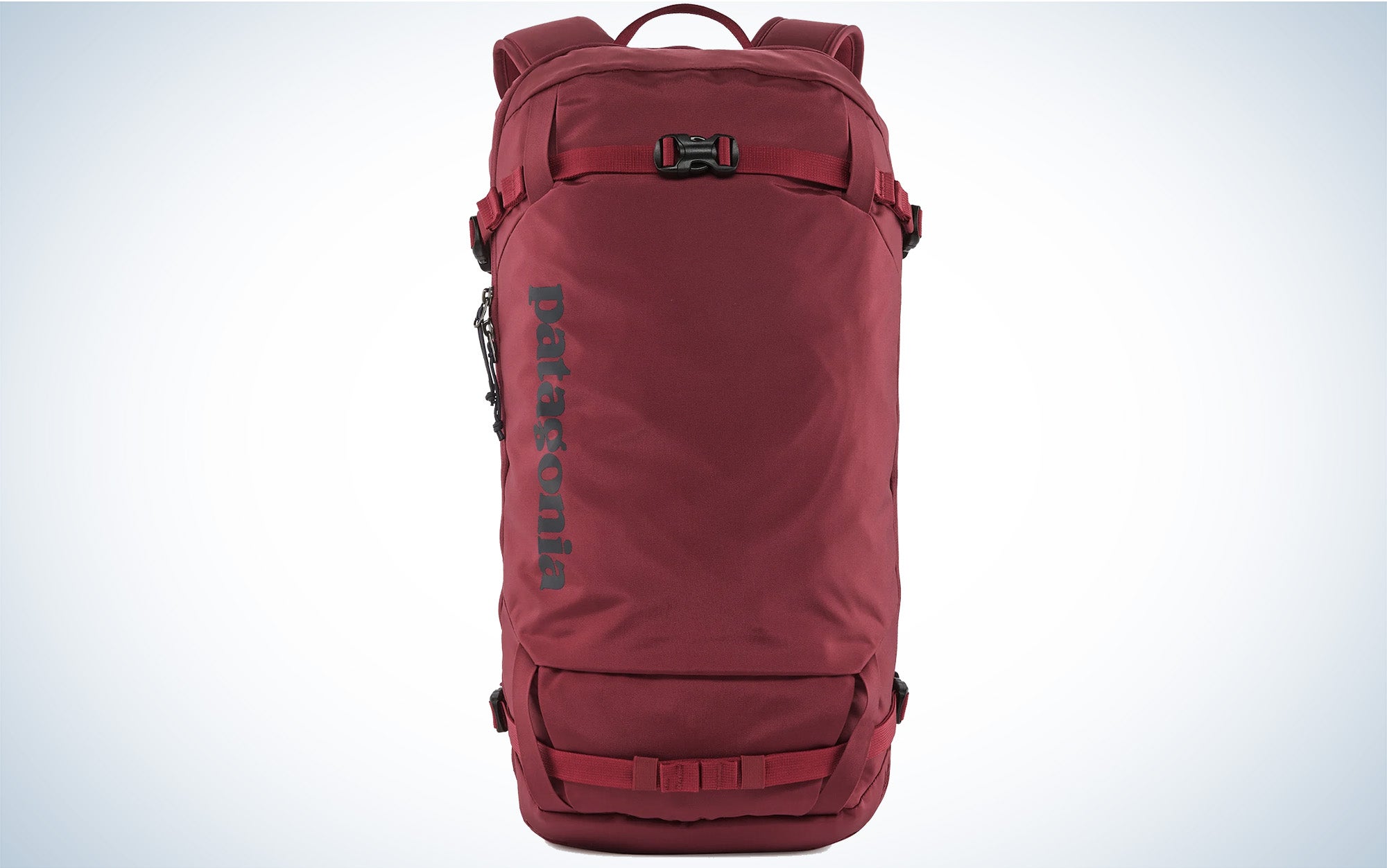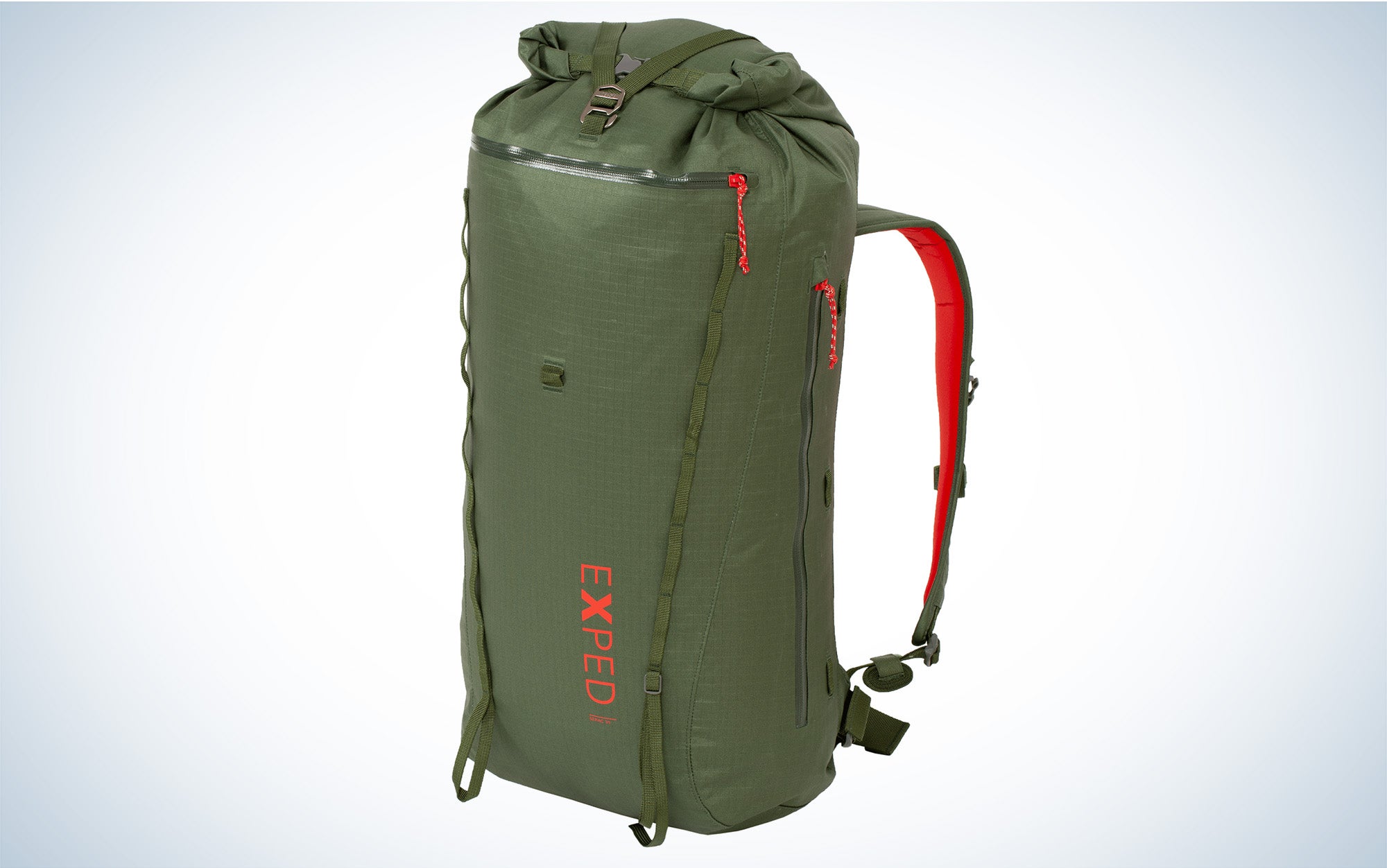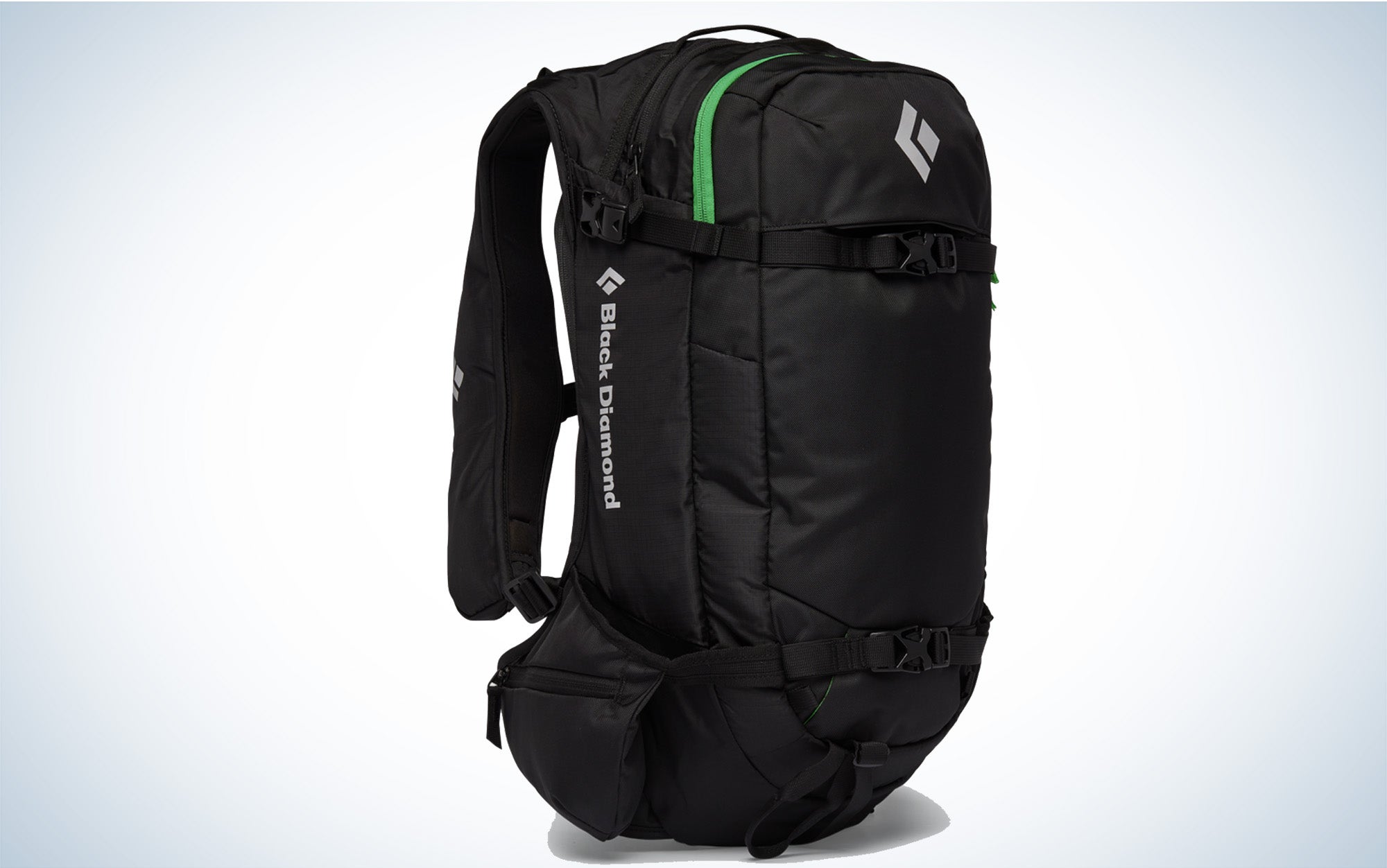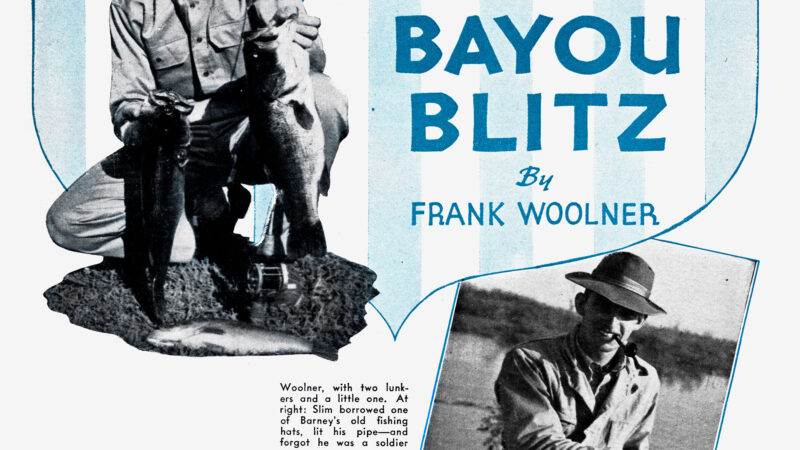The Best Winter Backpacks of 2023
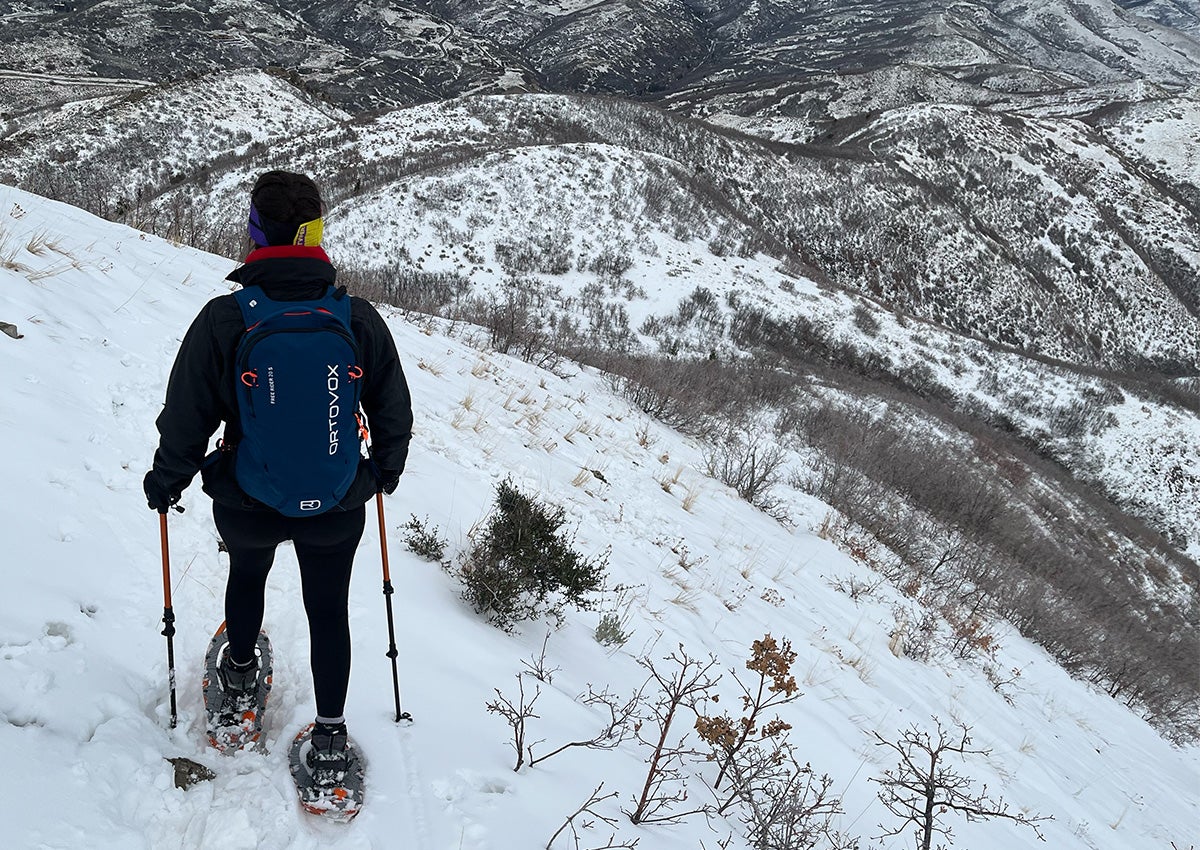
We may earn revenue from the products available on this page and participate in affiliate programs. Learn More ›
If you keep hiking, hunting, and backpacking through snow and freezing temps, you need a winter backpack. A specialty cold weather pack is important for weather resistance, safety tools, and more supplies. Your typical summer day pack is likely going to be too small and unfit for winter conditions. A waterproof or resistant pack capable of holding thicker layers, more gear, and extra snacks will improve your cold-weather adventures tenfold. Winter backpacks also deliver ingenious features for your favorite sports and ergonomic fits for skiing with a load on your back.
There are plenty of winter sports to account for, so I put the best winter backpacks through hands-on testing while skiing, touring, snowshoeing, hiking, and hunting to determine how well they perform in wet and cold conditions and compare their features.
- Best Overall: Mountain Hardwear Powabunga 32
- Best Ultralight: Arcteryx Rush SK 16
- Most Versatile: Rossignol Escaper Tour 25L
- Best for the Backcountry: Ortovox Free Rider 20 S
- Best for Snowboarders: Osprey Sopris 30
- Best for Skiers: Gregory Targhee Fasttrack 24
- Best for Hydration: Camelbak SnoBlast 22
- Best for a Full Day: Patagonia SnowDrifter 30L
- Best for Hunting: ExPed Serac 35
- Best for Resort Riding: Black Diamond Dawn Patrol 25
How I Tested Winter Packs
I took ten packs from top outdoor brands on a variety of activities to best judge which features, materials, and designs actually thrive in harsh winter conditions. While a snowshoer, skier, and hunter might value different specifications, the best winter backpacks should accommodate a variety of sports for the jack-of-all-trades outdoorsman or woman. Avalanche safety tool storage might not be necessary if you only ski at resorts or primarily hunt on snowy plains, but on backcountry expeditions in avalanche terrain, it’s a non-negotiable. Some winter sports can be gear intensive requiring helmets, ropes, crampons, ice axes, etc. A great winter pack should be able to accommodate all of this plus your daily essentials. So I tested all of these backpacks with a general focus on convenience, weather resistance, and quality while noting sport-specific features to better inform those in an exclusive relationship with a winter activity.
Best Winter Backpacks: Reviews & Recommendations
Best Overall: Mountain Hardwear Powabunga 32
Mountain Hardwear
Key Features
- Material: 500D Nylon
- Weight: 51.4 oz
- Sizes: S-M, M-L
- Dedicated Safety Tools Pocket: Yes
- Goggle Pocket: Yes
- Hipbelt Pockets: Single right-side zipper pocket
- Helmet Holder: Yes
- Hydration System Compatible: Yes
- Diagonal, A-frame, and centered carry options for skis and snowboard
- Back panel zipper for easy access
Pros
- Insulated hydration tube routing
- Removable sternum strap with whistle
- Top zip fleece-lined goggle pocket
Cons
- Ski loop cannot be stowed
The Powabunga’s padded hipbelt system provides mobility while the suspension moves with your natural skiing or boarding rhythm. The load lifter straps at the base of the neck, along with side compression straps and intuitive hipbelts, make this pack so streamlined to your body you’ll forget you have it on. The spring steel frame also provides flexibility, while retaining stable load transfer.
The front helmet hammock stows in a pocket and allows helmet carry on front or bottom to accommodate a-frame or diagonal ski carry. The lower diagonal ski loop is also stowable and has a quick deploy tab. The front panel is foam-reinforced to protect against diagonal ski or board edges and tools. The back panel is moisture wicking and snow shedding.

While there is an additional access point to the main compartment besides the back panel, it is inside the google pocket which can be restricting. However, there are large vertical side zipper pockets with expandable bellows for skins, extra gloves, or water bottles that are easy to access and aid in organization. The hipbelts are also adjustable and there is one pocket for hand warmers or snacks.
Best Ultralight: Arc’teryx Rush SK 16
Arc’teryx
Key Features
- Materials: High tenacity nylon pack cloth with nylon ripstop waterproof fabric in areas exposed to snow and moisture
- Weight: 25.7 ounces
- Sizes: One size
- Dedicated Pocket for Safety Tools: Yes
- Goggle Pocket: Yes
- Hipbelt Pockets: No
- Helmet Holder: Yes
- Hydration System Compatible: No
- Back panel zipper for easy access
- Snowboards carry vertically, skis A-frame or diagonally
Pros
- Lightweight
- Critical seams are taped for added water resistance
- Removable sternum strap with safety whistle
Cons
- Helmet hammock isn’t perfect
- Not hydration system compatible
This winter backpack is designed for speed. It’s small and lightweight for the fast and minimalist tour. Arc’teryx’s Rush SK is streamlined and thin but contains a lightly padded back panel with a frame sheet to comfortably carry loads. There are designated pouches in the main compartment for a probe, shovel, and shovel shaft. I specifically appreciated the mesh shovel pocket that spans the width of the bag minus room for the probe and shaft. While it’s not an entirely separate pocket, these mesh inserts provide great organization.
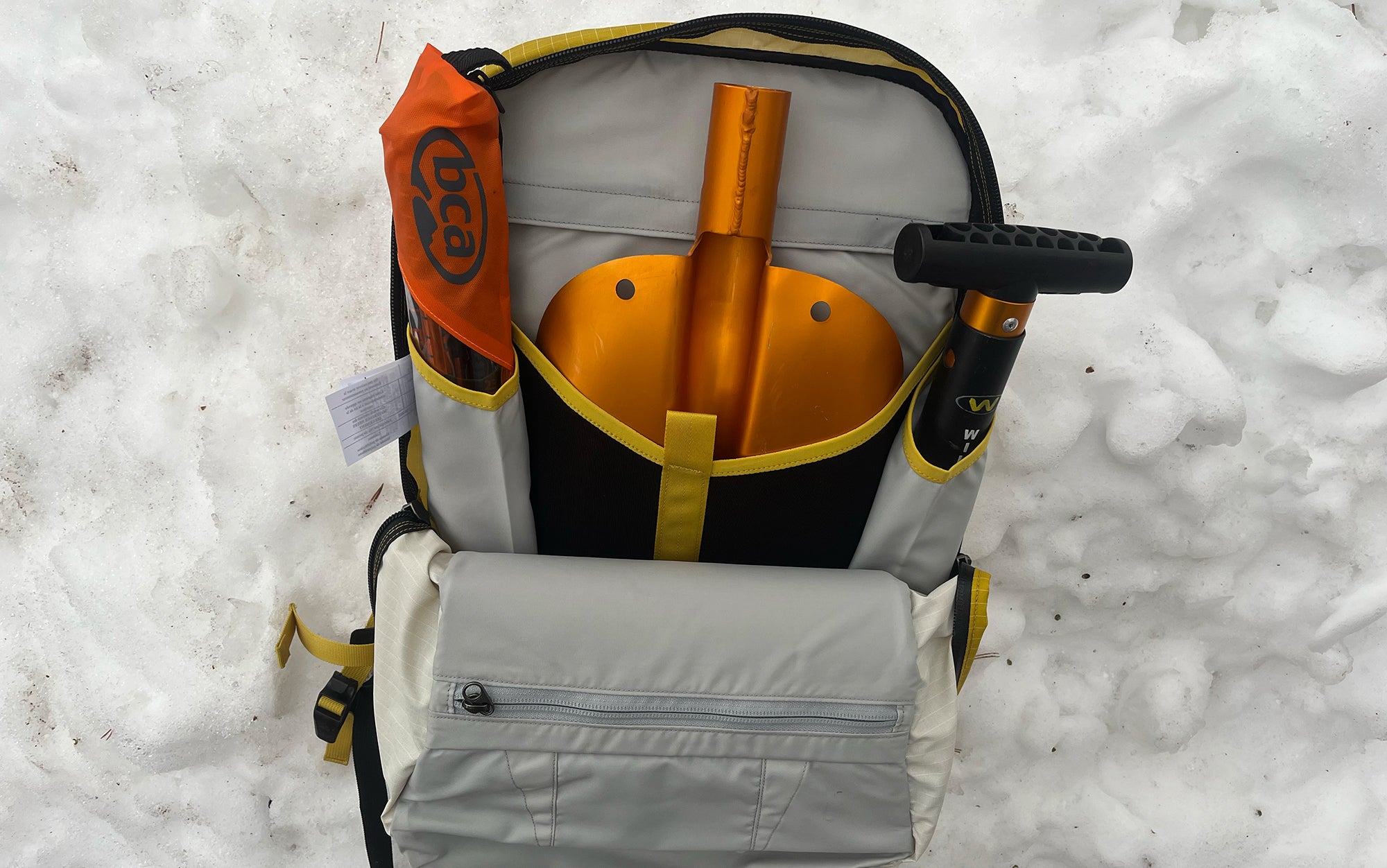
Even the reflective white interior makes you speedier at selecting items from the main compartment. One area not designed for a quick transition is the helmet hammock. It’s secured by four daisy chains and can be completely removed. However the tiny hooks and adjustments are difficult to maneuver especially when filled with snow while you’re wearing gloves.
Most Versatile: Rossignol Escaper Tour 25L
Rossignol
Key Features
- Material: 100 percent recycled polyester fibers
- Weight: 31.7 ounces
- Sizes: One size
- Dedicated Safety Tool Pocket: Yes
- Goggle Pocket: Yes
- Hipbelt Pockets: Single open mesh pocket
- Helmet Holder: Yes
- Hydration System Compatible: Yes
- A-frame and centered carry options for skis and snowboard
- Back panel zipper for easy access
Pros
- Hydration system compatible
- Versatile
Cons
- No insulation for hydration hose
From summer hikes to winter rides, this bag is the best all-season option. Made out of recycled polyester, it’s better for the environment, too. There is a convenient zipper pocket diagonal across the back and an open mesh hip pocket. I particularly appreciate the back panel zipper being on the outside of the straps as opposed to inside. This makes access much easier and quicker.
The Escaper Tour is a durable and weatherproof option all year long. It can hold your helmet, avy kit, and skis or supplies for a day hike. It doesn’t have excessive straps or buckles making it lightweight and minimalistic. However, there are lift loader straps for optimal fit and ergonomic suspension if you’re packing heavy. I was initially worried that my helmet would slip through the carry system as it appeared loose but there were no issues.
Best for the Backcountry: Ortovox Free Rider 20 S
Ortovox
Key Features
- Material: 100 percent polyamide 400D (recycled) PFC-free
- Weight: 34.6 ounces
- Sizes: One size
- Dedicated Pocket for Safety Tools: Yes
- Goggle Pocket: Yes
- Hipbelt Pockets: No
- Helmet Holder: Yes
- Hydration System Compatible: Yes
- Diagonal ski fastening
- Snowboard and snowshoe attachment
- Back panel zipper for easy access
Pros
- Chest strap with signal whistle
- Light colors inside make it easier to find your equipment
- Climate-neutral
Cons
- No hipbelt pockets
The Free Rider, like the Powabunga, fits extra snugly against the back due to a flat, elasticated flex belt. The soft bag also hugs the spine, so it doesn’t restrict movement. It’s streamlined to prevent catching, even when in difficult terrain. You can add an optional spine protector to this pack for intense backcountry excursions.
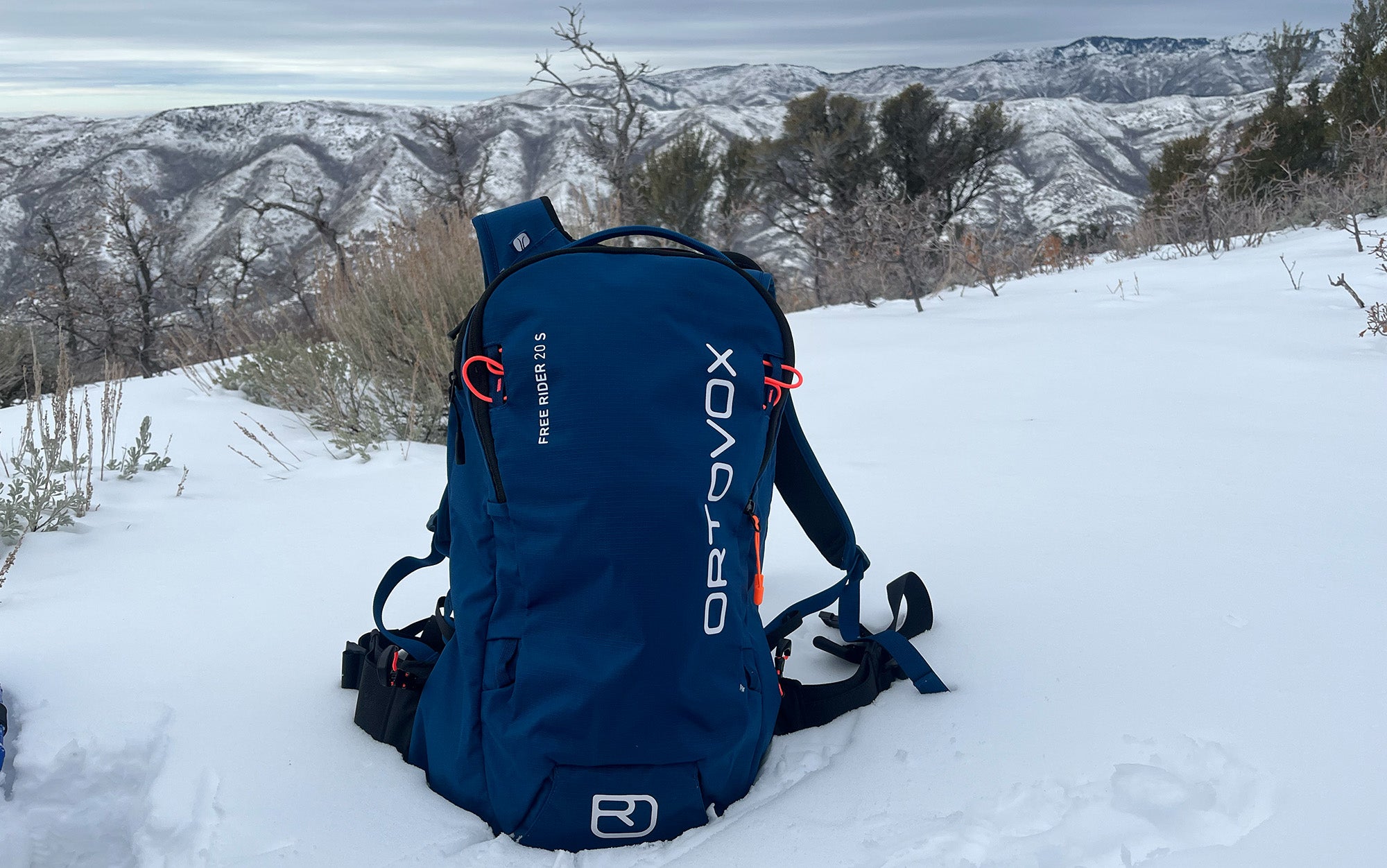
Ortovox’s helmet carry is the best of all the winter backpacks on this list. It fits snugly and easily with an attached stow-away pocket. There is also an integrated compression system where you can snug the backpack closer via two drawcords on the bottom and there are elastic loops to tuck the excess on the hipbelt. It fits comfortably and holds up in the elements. The design is intuitive and performs the best on backcountry missions.
Best for Snowboarders: Osprey Sopris 30L
Osprey
Key Features
- Materials: 210D High Tenacity Nylon with PFC-free DWR
- Weight: 38.8 ounces
- Sizes: S-M, M-L
- Dedicated Pocket for Safety Tools: Yes
- Goggle Pocket: Yes
- Hipbelt Pockets: One on the left side
- Helmet Holder: Yes
- Hydration System Compatible: Yes
- Back panel zipper for easy access
- A-frame carry skis or splitboard
- Horizontally or vertically carry a snowboard
Pros
- Dual-position helmet carry
- Secure ice tool carry sleeve and attachment point
- Adjustable sternum strap with safety whistle
Cons
- Only access to main compartment through back panel zipper
The Sopris is a technical backpack designed for touring. The thick and durable material sheds snow and reduces ice buildup. It also offers a stable fit, load lifters, and compression straps. However it does feel a little bulky, especially when it’s not full and there is no hydration tube insulation. The dual helmet carry positions are helpful, especially when carrying a snowboard vertically. The only way into the main compartment is through the back panel which can be a headache, but if you have a loaded pack or are sitting on the lift, this is how you’ll most likely access the main area anyway.
Best Feature: Gregory Targhee FastTrack 24L
Gregory
Key Features
- Materials: 100D high density nylon and 210D high density nylon. The lining is 40 percent post-consumer recycled 135D polyester.
- Weight: 42.4 ounces
- Sizes: S-M, M-L
- Dedicated Pocket for Safety Tools: Yes
- Goggle Pocket: Yes
- Hipbelt Pockets: One zippered pocket on the left
- Helmet Holder: Yes
- Hydration System Compatible: Yes
- FastTrack ski carry friction hook system allows you to stow skis without removing your pack
Pros
- Dual layer bottom panel for added durability
- Anodized aluminum hardware for function in the cold
- Removable sternum strap with safety whistle
- Lightweight mode
- Tool blade for ice ax
Cons
- Heaviest pack
- Zipper flap
The Targhee FastTrack’s number one draw is the FastTrack technology that allows the user to mount and dismount skis without taking off the pack. The design is ingeniously simple. Be warned that you will have to carry both skis on one side of the pack to use the FastTrack lanyard. Essentially an elasticized webbing attached to the right shoulder will wrap around your skis, keep them in place, and secure to your left shoulder strap. The skis are taught to the side of the pack with an easy release loop ready for dismount. If you’re doing a lot of boot packing then this bag will shave time off your transitions and you don’t have to set your bag in the snow to unload your skis.
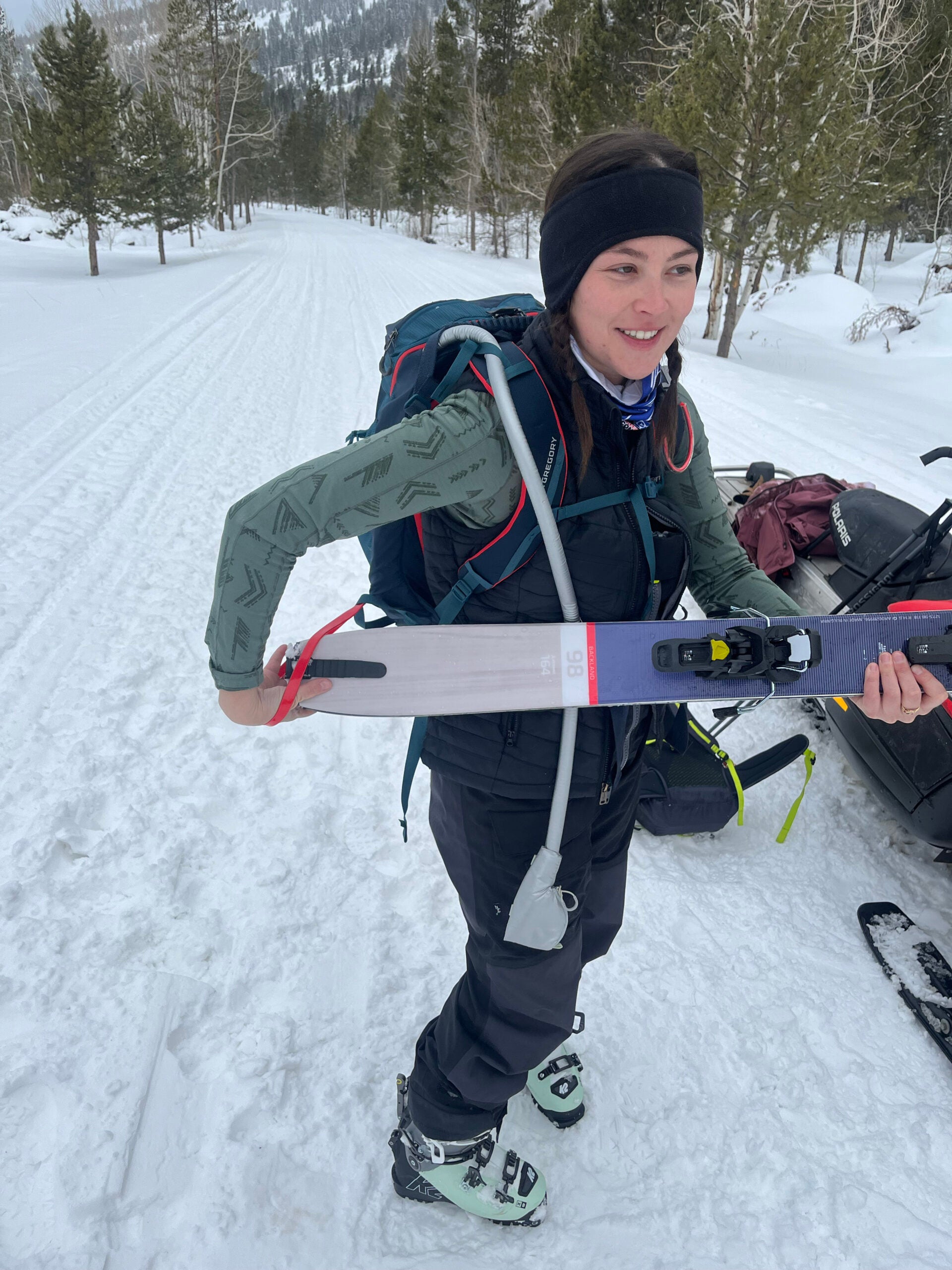
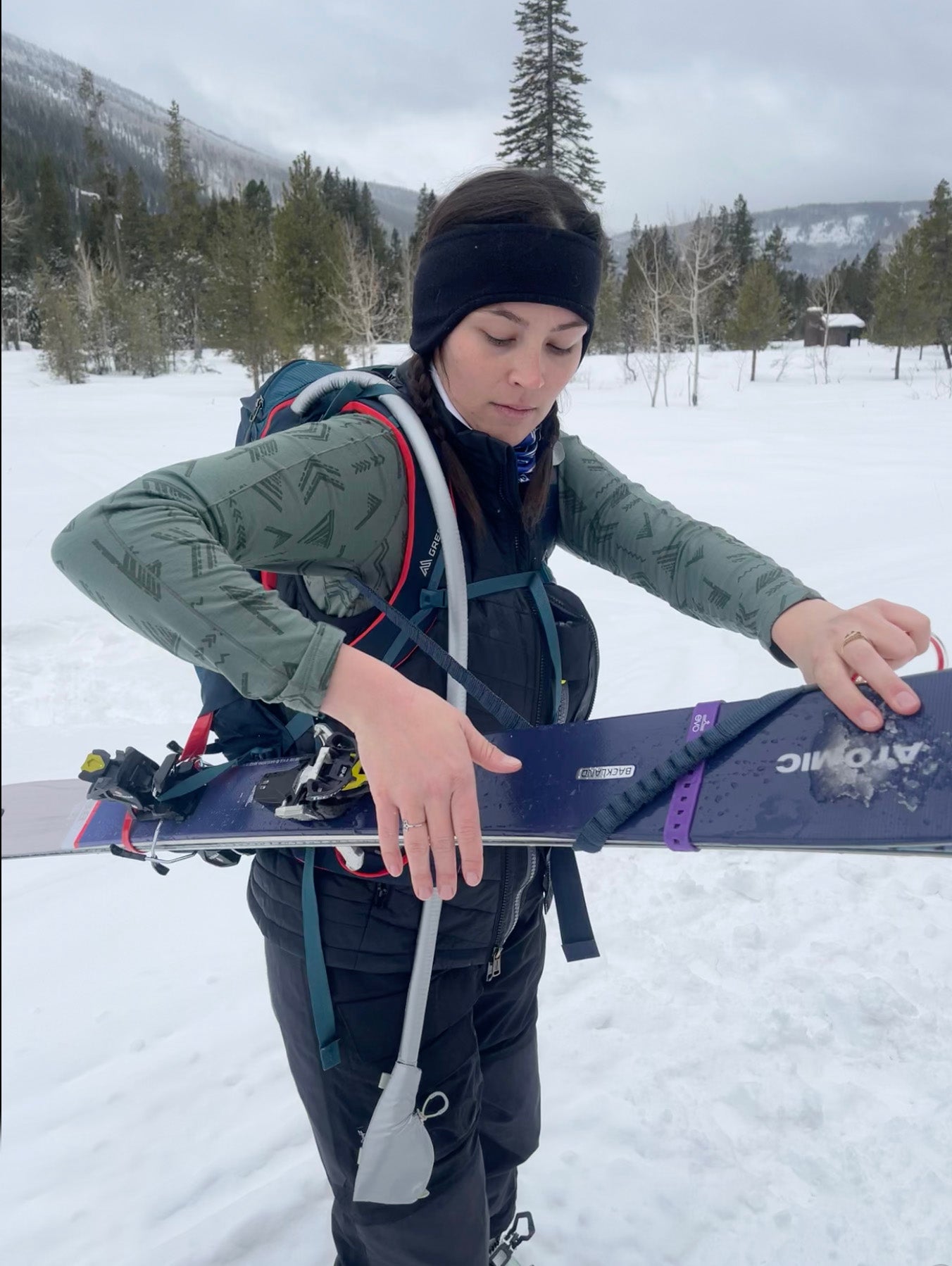
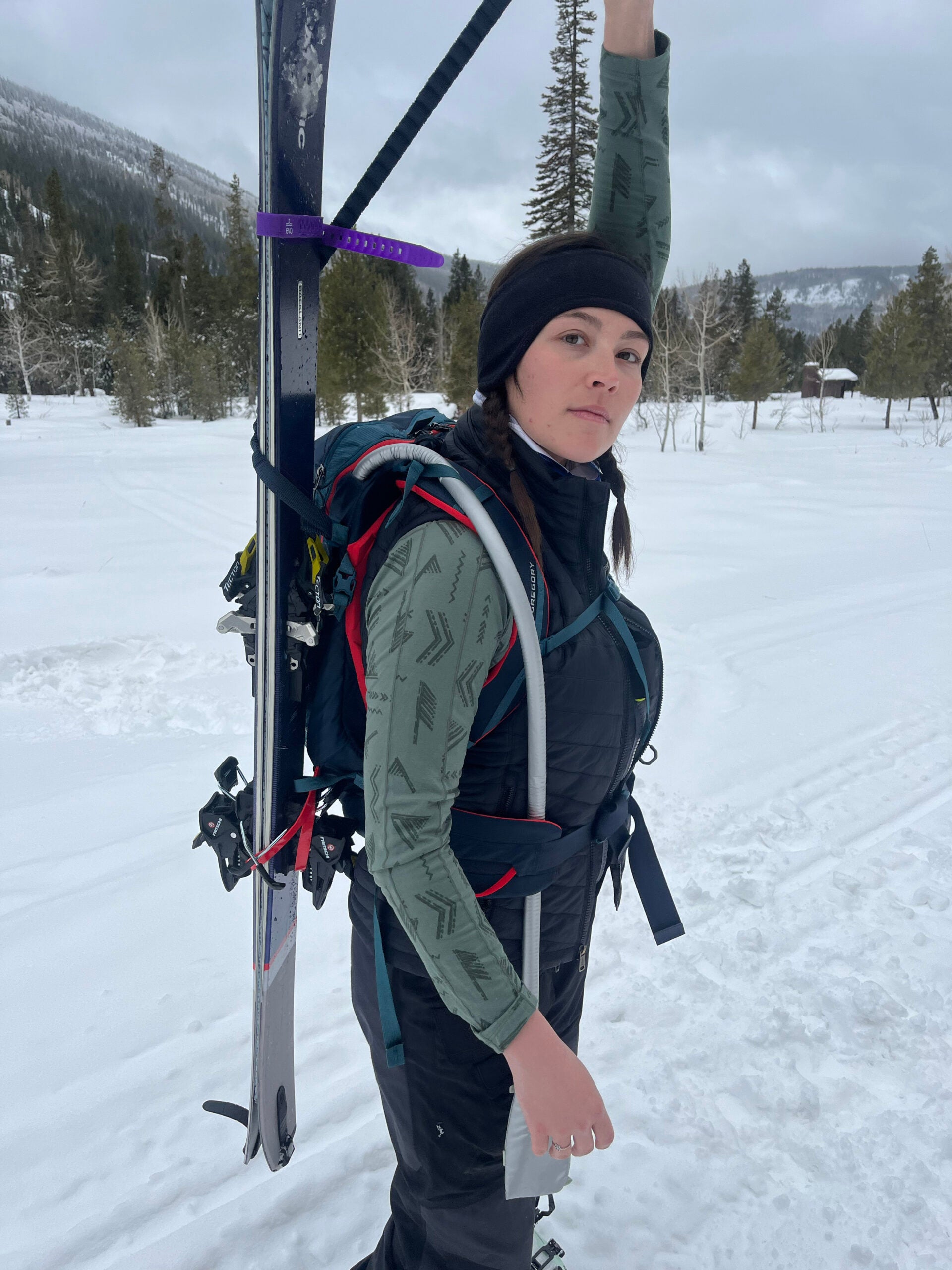
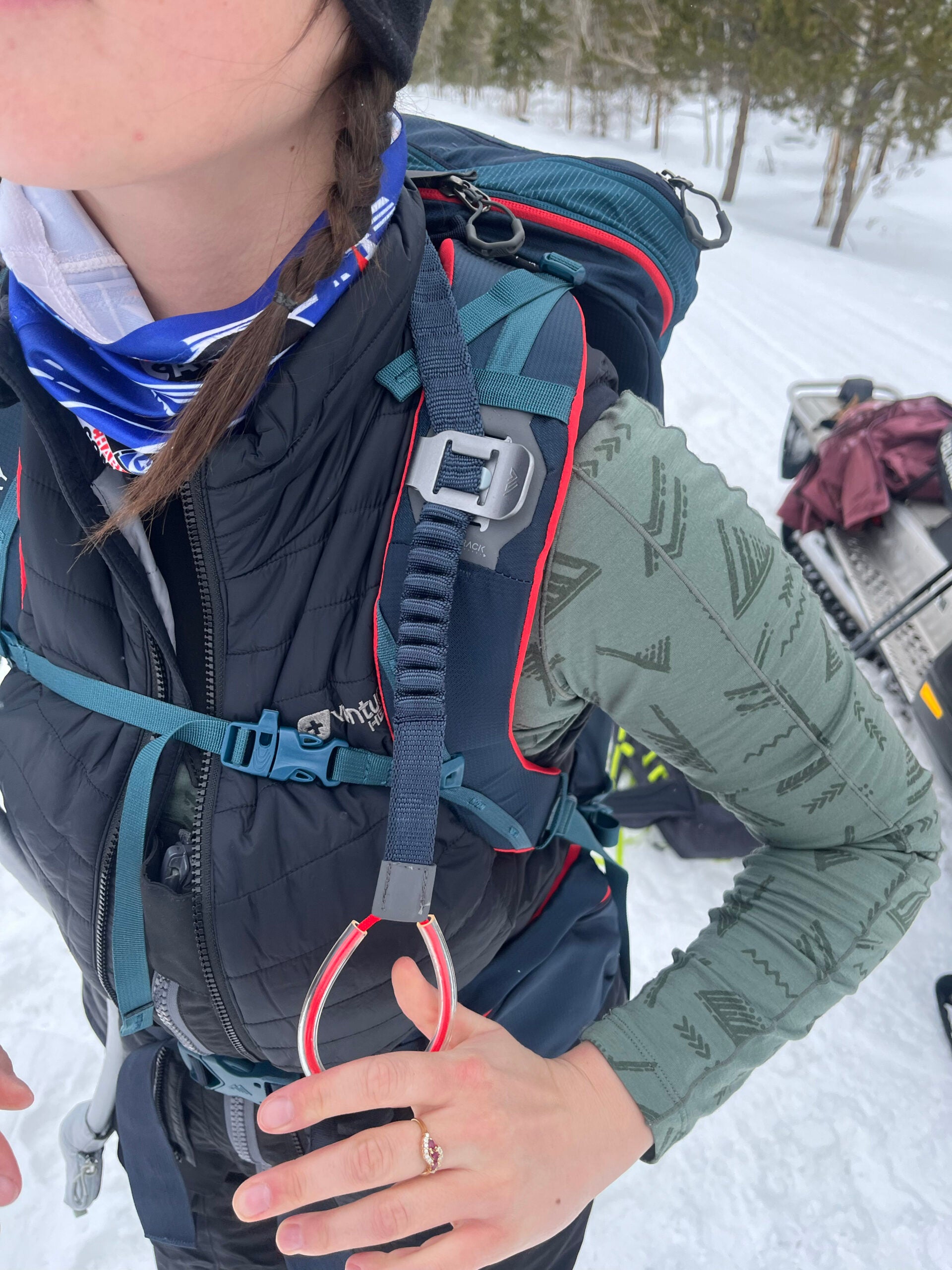
This pack is on the heavier side with seemingly unnecessary additions such as a large zippered pocket for the helmet hammock that will remain unzipped and unusable while carrying a helmet. There are toggles and a protected pick sleeve for attaching an ice ax, which although stable, would do just fine with one or the other. There is a lightweight mode but you’ll lose your hipbelts and frame sheet (stabilizing back panel) to get there.
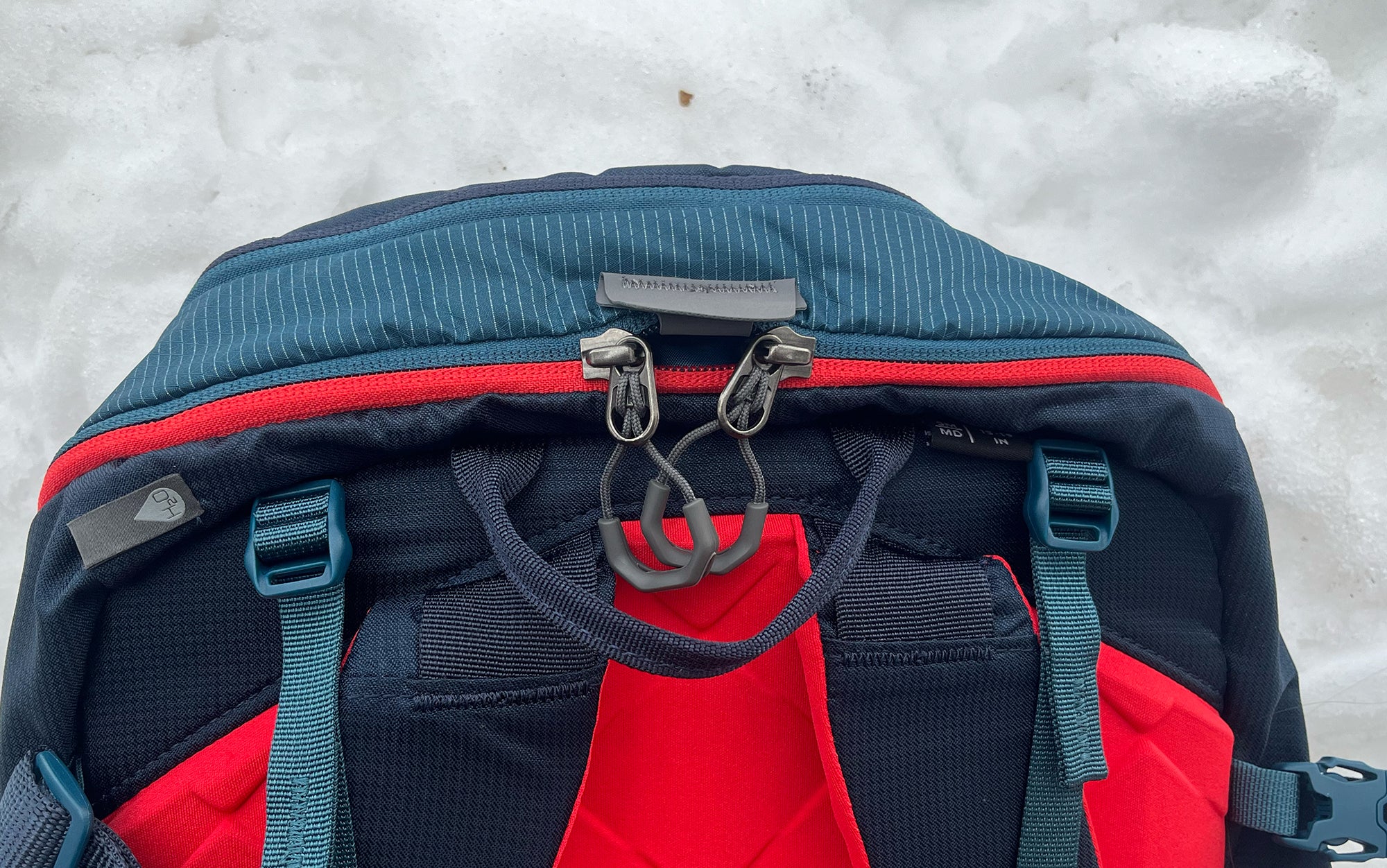
There is only one access point to the main compartment which is the top zipper. Granted, the ski mount method associated with this backpack allows you to access the main pocket with skis loaded so you won’t technically need a back panel zipper. The main zipper initially gives access to avalanche tools and then a drawstring contained sack is the main compartment.
One odd detail is that the main zipper has a gap in it where the track stops at the top of the pack. This gap is protected by a flap to discourage the elements from falling into your pack. It is designed to allow for easy gloved access to your safety tools, but I would much prefer my bag close completely. This design also stops the user from operating the dual zipper system to its full advantages. Instead, the only way to “close” this pack is by zipping both zippers to the middle until they hit the stopping point. It’s worth noting that the zipper is strong enough to stay closed even while loaded without slowly unzipping, for now.
Best for Hydration: CamelBak SnoBlast 22
CamelBak
Key Features
- Materials: Snow Shield material sheds snow and keeps pack dry all day
- Weight: 36 ounces
- Sizes: S-M, M-L
- Dedicated Pocket for Safety Tools: Yes
- Goggle Pocket: Yes
- Hipbelt Pockets: No
- Helmet Holder: Yes
- Hydration System Compatible: Yes
- Tri-zip access with a back panel zipper
- A-frame or vertically carry skis or snowboard
Pros
- 2-liter Crux reservoir with the Therminator harness that keeps hose insulated
- Lift access QR harness
Cons
- No helmet carrier
I took this pack hiking through a slot canyon and ski touring. It performed well in both locations. The material wasn’t damaged or scratched after climbing through narrow rock walls. The tri-zipper is the best access of all of the best winter backpacks. And although it doesn’t have an external helmet hammock, my helmet fit just fine inside the backpack with the rest of my supplies. There are external attachment points that let you strap on additional gear but you’ll probably need extra straps unless you’re willing to use your compression straps. The bag also has a zipper that will expand or compress the pack depending on how much gear you need.
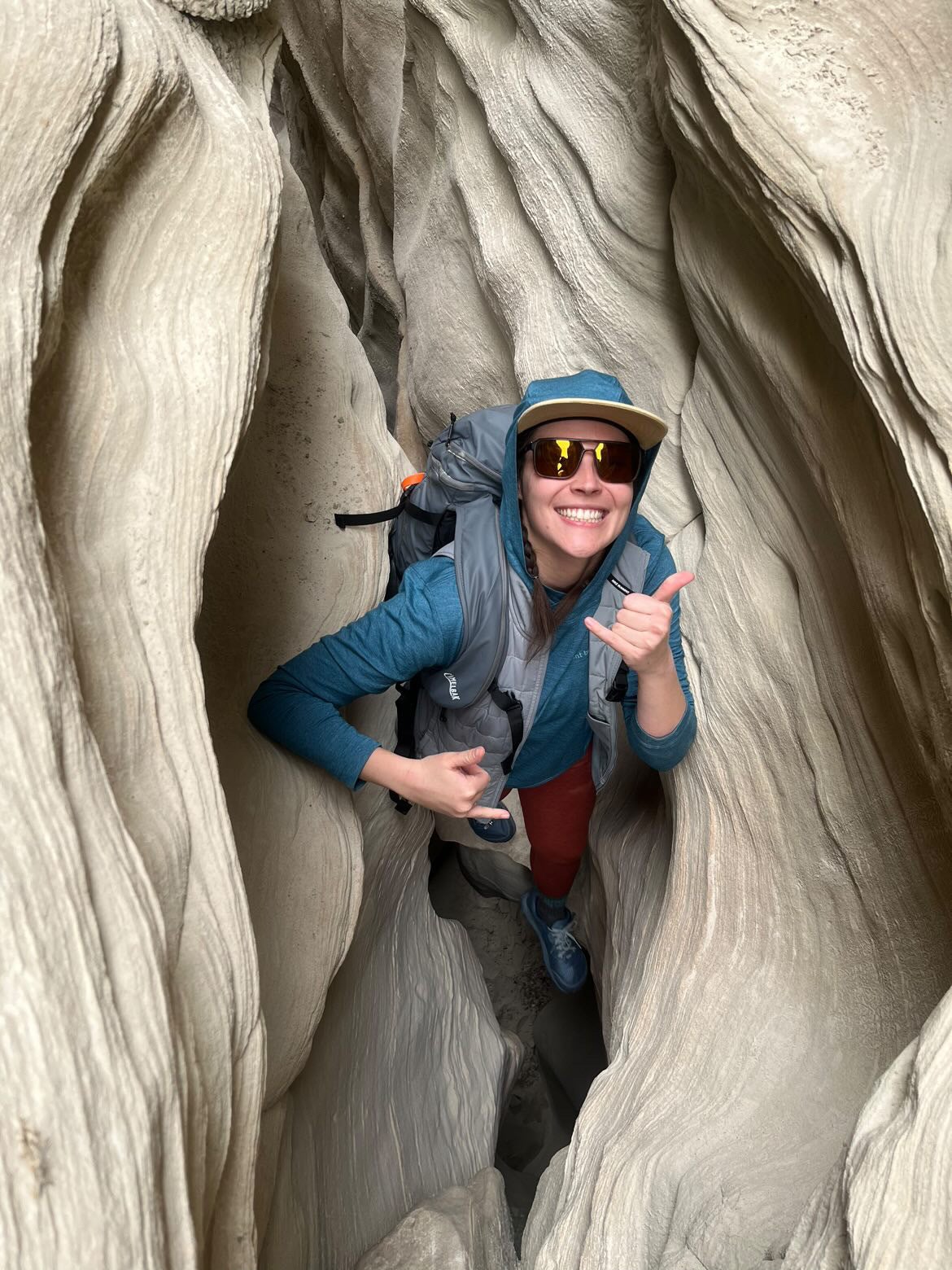
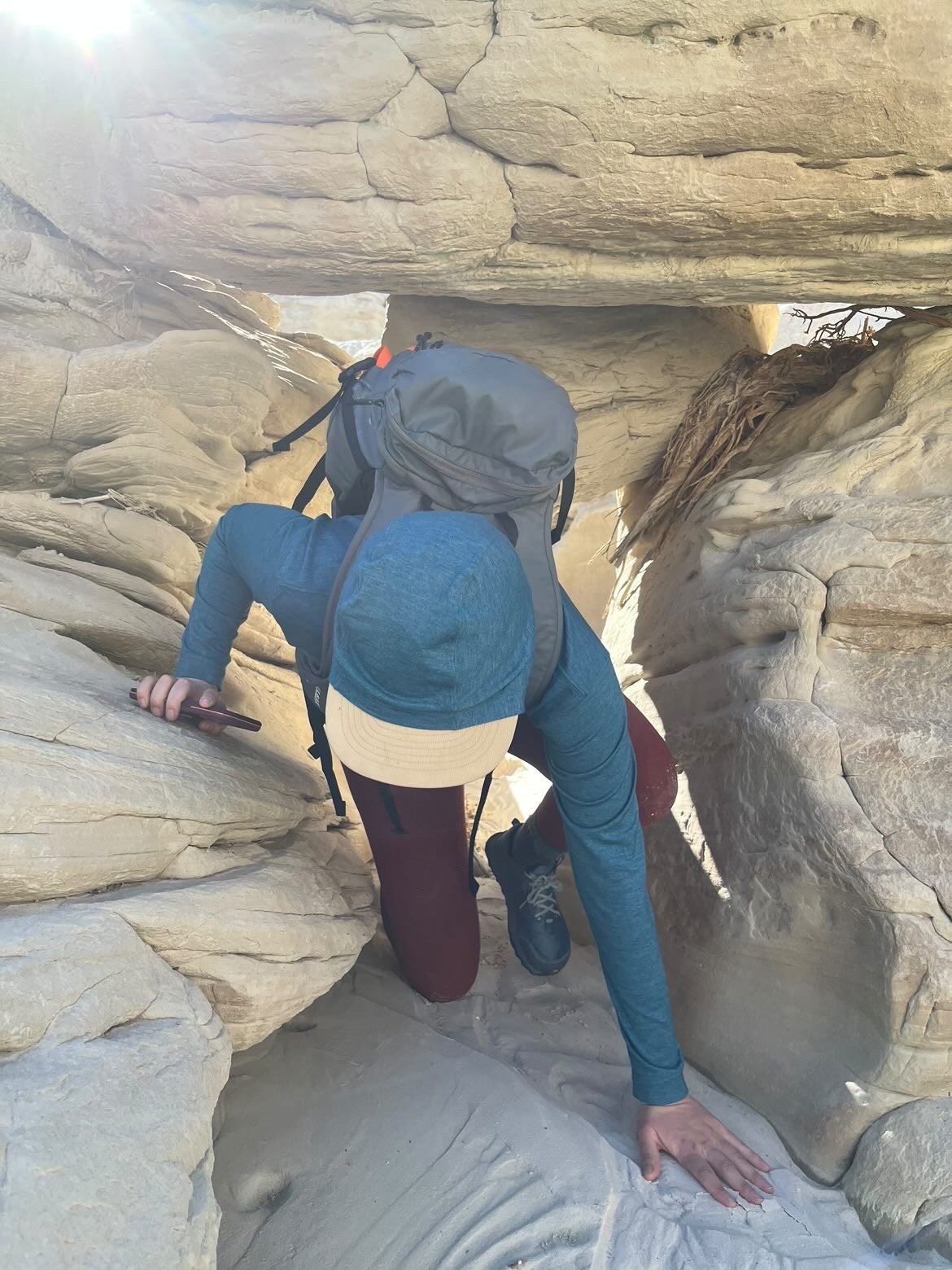
The SnoBlast comes with a 2-liter hydration reservoir and an insulated hose. This fits nicely into a pocket along the shoulder strap to keep your water from freezing in the hose during mild winter conditions. This bag is particularly resort friendly because the QR harness features rip cords on each shoulder strap that allow you to quickly loosen the bag entirely if it were to get caught on a lift or other obstacle.
Best for a Full Day: Patagonia SnowDrifter 30L
Patagonia
Key Features
- Materials: 100 percent recycled 6.4-ounce 420D nylon for puncture and abrasion resistance with a PU coating and a DWR finish
- Weight: 42 ounces
- Sizes: S-M, L-XL
- Dedicated Pocket for Safety Tools: Yes
- Goggle Pocket: Yes
- Hipbelt Pockets: Yes
- Helmet Holder: Yes
- Hydration System Compatible: Yes
- Diagonal, A-frame, and centered carry options for skis and snowboard
- Back panel zipper for easy access
Pros
- Hipbelt pockets
- Spacious
Cons
- No hydration hose insulation
Patagoina’s SnowDrifter is a cavernous bag with plenty of room for an intensive load. It has hipbelt pockets, backpanel access and a main zipper to the largest pocket, a googles pocket, and a separate avy kit pocket with straps. It also has a stow-away helmet holder and straps for mounting skis, boards, or other tools. If you need to load up one of these winter backpacks, this would be the one. Spacious with tons of straps, it can handle a highly technical day trip.
Best for Hunting: ExPed Serac 35
ExPed
Key Features
- Materials: PFC-free waterproof rip-stop Nylon with a water column of 10,000 mm, taped seams, and weatherproof zippers ward off moisture and snow
- Weight: 29.8 ounces
- Sizes: S, M, L
- Dedicated Pocket for Safety Tools: Yes
- Goggle Pocket: No
- Hipbelt Pockets: No
- Helmet Holder: No
- Hydration System Compatible: No
- Back panel zipper for easy access
- Diagonal carry skis
Pros
- Weatherproof main compartment with roll-top closure
- White interior for quick overview of contents
Cons
- No hipbelt pockets
- Not hydration system compatible
- No helmet holder
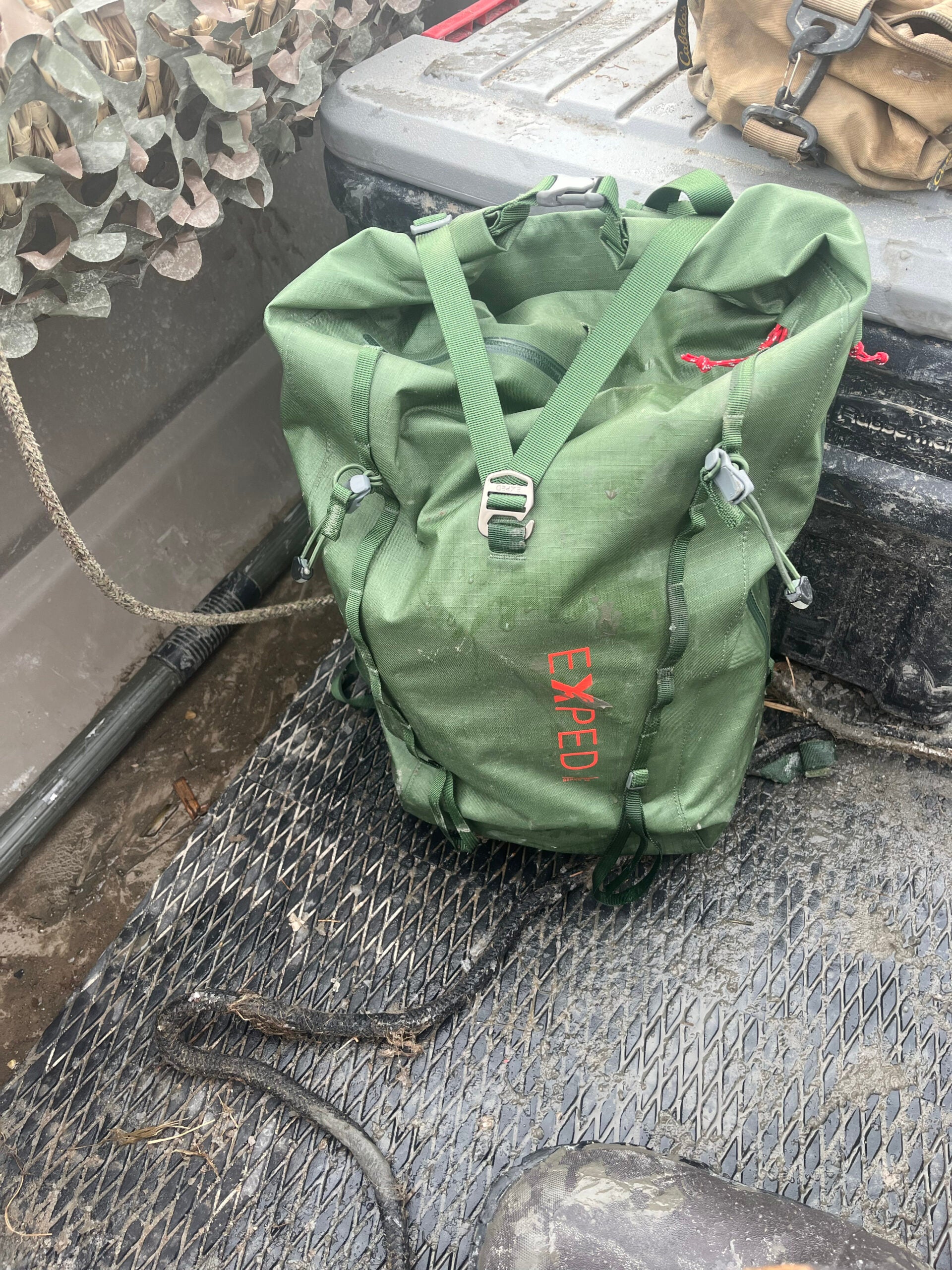

The main draw of this winter backpack is that it is almost a dry bag. The side zippered access into the spacious main compartment is the only reason it isn’t technically waterproof when submerged. But aside from a full dip, your gear is going to stay dry in this bag. The Serac has a weatherproof front zippered pocket for quick access to avalanche gear but there are no designated interior pockets for specific tools. Its minimalist design features two daisy chains on the back for any equipment you might need. I took this bag duck hunting where it sat in wet, muddy, and freezing conditions with no consequences.
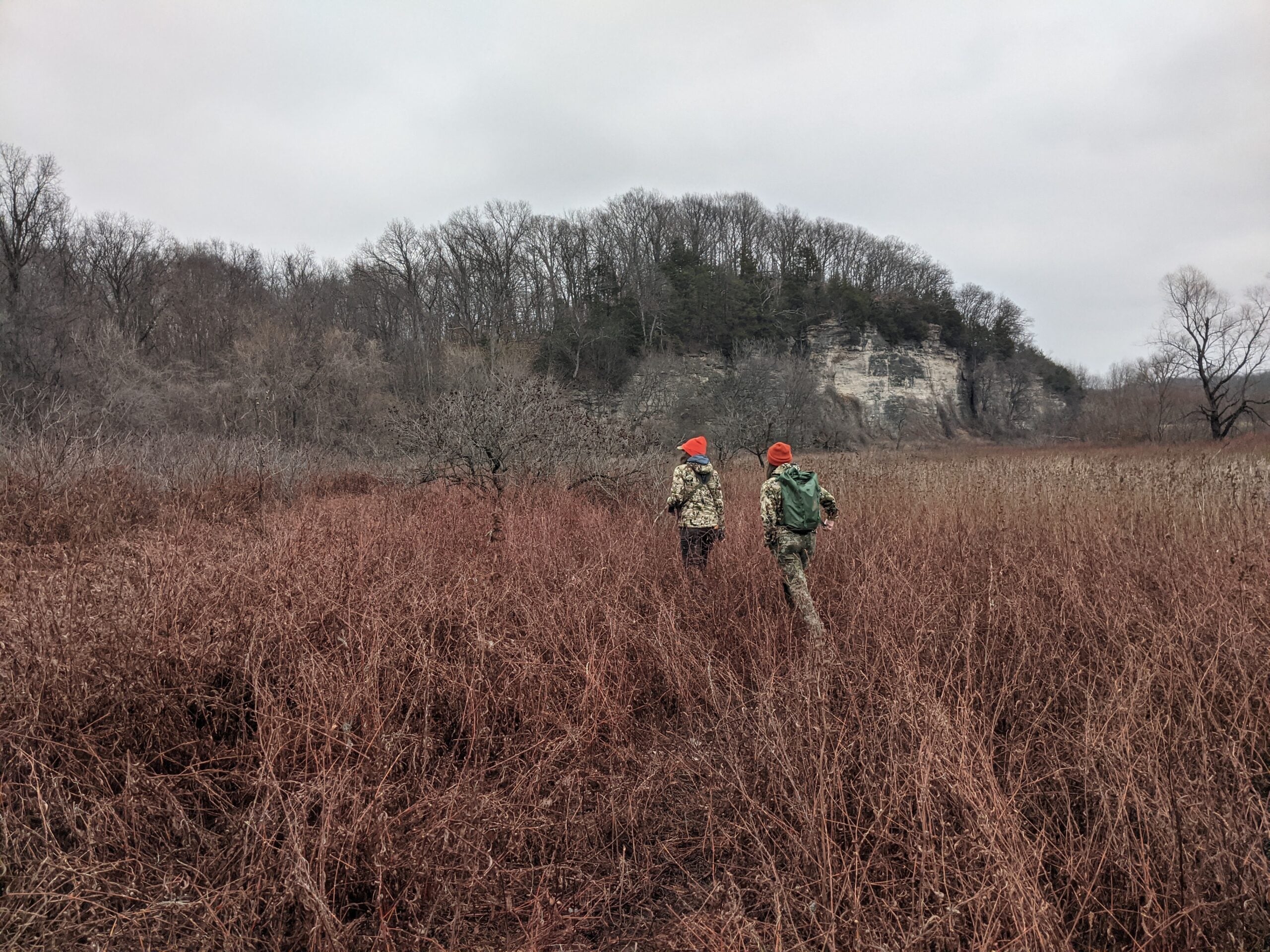
The material is durable and I thoroughly abused it through an airport and scouting for deer. This would also be a great bag for mountaineering, climbing, or canyoneering thanks to its weatherproofing, slim profile, and lightly padded back. There is a removable hip belt with no padding or pockets that connects via two sleek metal “buckles” that don’t actually engage but simply slip through each other. This does decrease the risk of snow or ice freezing into a plastic buckle and causing issues.
Best for Resort Riding: Black Diamond Dawn Patrol 25L
Black Diamond
Key Features
- Materials: 100 percent post-consumer recycled 840D Polyester and 210D Ripstop Nylon
- Weight: 41 ounces
- Sizes: S-M, M-L
- Dedicated Pocket for Safety Tools: Yes
- Goggle Pocket: Yes
- Hipbelt Pockets: Yes
- Helmet Holder: Yes
- Hydration System Compatible: Yes
- Exterior attachment points accommodate skis, snowboards, helmet, and ice ax
Pros
- Hydration hose or radio cord insulated shoulder pocket
- Hi-Lo helmet hammock for two possible helmet storage options
- Rubber loops under front straps for added grip when carrying skis or boards
- Ice ax pocket
Cons
- Main pocket is only accessible from back panel zipper
- Buckles and strap adjustments aren’t instinctual
While the bag is form-fitting, the lack of load lifter straps doesn’t give this winter backpack the same body-hugging fit as the Powabunga. I did enjoy the large hip-belt pockets built to store skins for the downhill. The buckles are designed to be glove friendly and they do work, but you have to get used to unlocking each buckle before tightening or loosening any straps. This pack’s hipbelt also shares the metal slip-through buckle system as the Serac. Like the Sopris, the Dawn Patrol’s only access to the main compartment is through the back panel. Annoying when packing or stowing you bag in a locker, but while skiing it’s fine.
What To Look For In the Best Winter Backpacks
Safety
Recreating in the backcountry, where avalanche danger is prevalent, means you should have a probe and shovel in your pack at all times. Many of the bags on this list contain a special compartment for these items. These pockets should make identifying, accessing, and deploying your tools as easy as possible in the event of an emergency. Choose a bag with one of these specialized compartments if you plan to tour or snowshoe in the backcountry.
Weather Resistant
The last thing you want is for your warm, dry layers to get wet just sitting in your pack. The best winter backpacks should be water resistant and shed snow instead of accumulating it. Polyester and nylon resist water, and some are coated in Durable Water Repellent (DWR). Some are PFC-free which means they don’t use chemicals harmful to the environment in their water repellent finish.
Gear Organization
It’s cold, you have gloves on, and maybe you don’t want to let more snow into your pack than absolutely necessary. So when you dive into your bag for another layer, a snack, or a tool, organization is key. If you have to dig into your bag on the lift, you also won’t want to drop anything. Pockets for essentials, easy-access zippers, and glove-friendly hardware are going to make your life much easier in the winter months.
Most winter bags have either a back panel zipper, additional access points to the main pocket, or both. This allows you to get at your gear on the lift or even if your pack is loaded without taking skis off. The back panels also allow you to put your bag on the snowy ground to unpack without getting the back of your pack wet. Depending on the activity, you might need crampons, an ice ax, rope, a harness, or snowshoes to complete a mission and your pack should provide the necessary features to store these specialty tools.
Hydration System Compatible
It’s hard enough to hydrate in the winter without digging through your pack for a frozen water bottle. I prefer to make sure my bag has an interior hydration sleeve or a universal buckle hanging system and a hydration port for my bladder. This keeps my bladder close to my body for warmth, and with an insulated hose or designated hose pocket lets you drink water without taking off your pack. Admittedly these insulation methods work best in mild temperatures, but an easy trick is to blow air back through your hose, so your mouthpiece doesn’t freeze.
Read Next: The Best Hydration Packs of 2023, Tested and Reviewed
FAQs
Q: What is a winter backpack?
A winter backpack is specifically designed for snowy and cold conditions. Typically they will include a designated space for avalanche safety tools, keep your gear dryer than a summer pack, and have more room for extra layers and supplies.
Q: How do you attach skis to a backpack?
You can attach skis to a backpack in a variety of ways: diagonally, vertically, horizontally, and A-frame. The best winter backpacks will have the necessary attachment points to accommodate most ski and snowboard carry positions. The Gregory Targhee FastTrack has its own method to attach skis or a splitboard without taking off the pack, but the rest have loops and/or straps to allow for multiple carry methods.
For diagonal, vertical, and A-frame, you’ll need to make sure a strap or loop is taught underneath the binding of your ski so that when you’re standing, the binding can rest on this strap. To A-frame carry your skis or splitboard, you’ll need a voile strap to fix the tips together while attaching each ski to a side of the pack. The horizontal method means strapping your skis to the top of your pack. Snowboarders can also slide their board between your back and pack and through the straps for short hikes.
Q: What should you bring winter hiking?
Recreating in winter can have dire consequences for the ill-prepared. If you get lost hiking in the summer and have to spend the night outside, you’ll most likely be OK. When temperatures drop, an unexpected overnight could be fatal. Bring water that isn’t frozen, more snacks than you think you need (you burn more calories exercising in winter), extra warm layers, navigation tools, and micro-spikes for frozen terrain. To be prepared for the worst, consider a fire starter, emergency blanket, and personal locator beacon or satellite communicator.
Final Thoughts on the Best Winter Backpacks
The best winter backpacks merge safety and weatherproofing with streamlined features and plenty of storage options. Depending on your intentions for your new pack, this list has an option for any one-day winter excursion. The best for hiking might be the Camelbak SnoBlast for its stellar hydration system or the Rossignol Escaper Tour for its versatility. The best for touring could be the Ortovox Free Rider or the Gregory Targhee FastTrack for skiers and split boarders looking to lap before work.
- Best Overall: Mountain Hardwear Powabunga 32
- Best Ultralight: Arcteryx Rush SK 16
- Most Versatile: Rossignol Escaper Tour 25L
- Best for the Backcountry: Ortovox Free Rider 20 S
- Best for Snowboarders: Osprey Sopris 30
- Best for Skiers: Gregory Targhee Fasttrack 24
- Best for Hydration: Camelbak SnoBlast 22
- Best for a Full Day: Patagonia SnowDrifter 30L
- Best for Hunting: ExPed Serac 35
- Best for Resort Riding: Black Diamond Dawn Patrol 25
The post The Best Winter Backpacks of 2023 appeared first on Outdoor Life.
Articles may contain affiliate links which enable us to share in the revenue of any purchases made.
Source: https://www.outdoorlife.com/gear/best-winter-backpacks/

